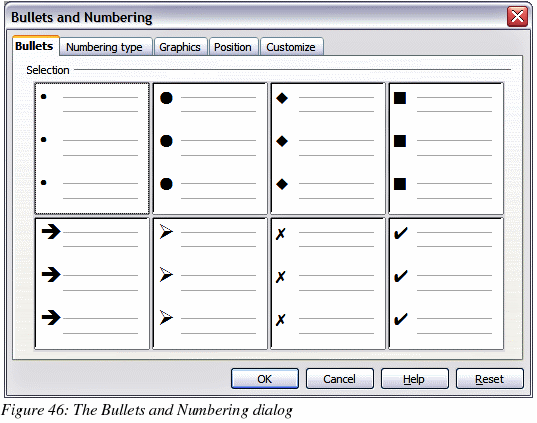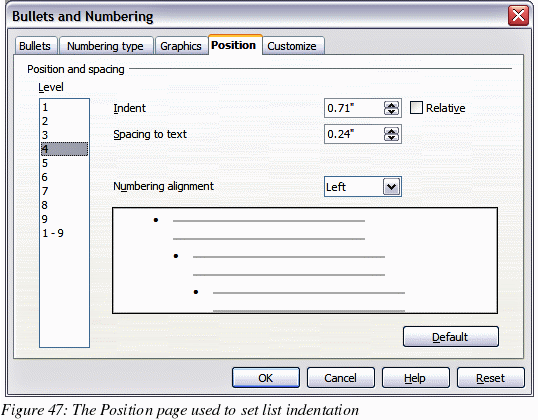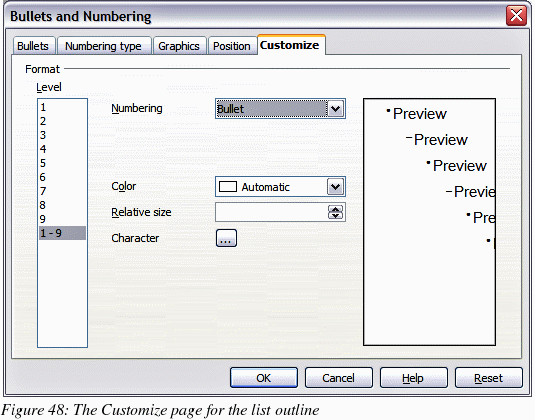Creating bulleted and numbered lists
The
procedure to create a bulleted or numbered list is quite different
depending on the type of text box used, although the tools to manage
the list and customize the appearance are the same.
In
text boxes created automatically by Impress (called AutoLayout), the
outline styles available are by default bulleted lists, while for
normal text boxes an additional step is required to create a
bulleted list.
Creating
lists in AutoLayout text boxes
Every
text box included in the available layouts is already formatted as a
bulleted list, therefore to create a bulleted list the only
necessary steps are:
From
the Layout pane, choose a slide design that contains a text box.
Those are easily recognizable from the thumbnail.
Click
in the text box that reads Click
to add an outline.
Type
the text, then press Enter
to start a new bulleted line.
The
default list type is a bulleted list. The mechanisms to change the
list from bulleted to numbered and vice versa are explained in “Changing the appearance of the list”.
|
Tip
|
Press
Shift
+ Enter to
start a new line without creating a new bullet or number. The new
line will have the same indentation of the previous line. Press
instead the button bullets on/off on the text formatting toolbar
for a line without bullet. If the text formatting toolbar is not
showing, enable it selecting View
> Toolbar > Formatting
in the menu bar.
|
Creating
lists in other text boxes
To
create a list in a text box, follow these steps:
Place
the cursor in the text box.
Click
the Bullets On/Off
button
 on the text formatting toolbar. If the text formatting toolbar is
not showing, enable it by selecting View
> Toolbar > Formatting from the menu bar.
on the text formatting toolbar. If the text formatting toolbar is
not showing, enable it by selecting View
> Toolbar > Formatting from the menu bar.
Type
the text and press Enter
to start a new bulleted line.
The
default list type is a bulleted list. The mechanisms to change the
appearance of the list are explained on page 67.
Creating
a new outline level
If necessary,
press Enter
to begin a new line.
Press
Tab.
Each time you press Tab
the line indents to the next outline level. Pressing Enter
creates a new line at the same level as the previous one. To return
to the previous level, press Shift+Tab.
In
the AutoLayout text boxes, promoting or demoting an item in the list
corresponds to applying a different outline style, so the second
outline level corresponds to Outline 2 style, the third to Outline 3
style and so on.
|
Caution

|
Unlike
styles in Writer, do not try to change the outline level by
selecting the text and then clicking the desired outline style.
Due to the way the presentation styles work, it is not possible
to apply them in this way.
|
Changing
the appearance of the
list
You
can fully customize the appearance of a list, changing the bullet
type or numbering for the entire list or for single entry. All the
changes can be made using the Bullets and Numbering dialog, which is
accessed by selecting Format
> Bullets and Numbering or by clicking on the Bullets
and Numbering
icon
 on
the
text formatting toolbar.
on
the
text formatting toolbar.
Selecting
the entries
For the entire
list:
Select
the entire list or click on the gray border of the text box so that
just the green resizing handles are displayed.
Select
Format > Bullets and
Numbering or click on the Bullets and Numbering
icon.
The
Bullets and Numbering dialog (Figure 46) contains five tabs:
Bullets, Numbering type, Graphics, Position, and Customize.
If
a bulleted list is needed, select the desired bullet style from the
six default styles available on the Bullets
page.
If
a graphics style is needed, select one from those available on the
Graphics
page.
If
a numbered list is needed, select one of the 6 default numbering
styles on the Numbering
type page.
Later
in this section is an explanation on how to add further bullets and
numbering styles to the existing ones.

For
a single line in the list:
Click
anywhere in the line to place the cursor in it.
Follow
steps 2–4 of the previous instruction set.
If
the list was created in an AutoLayout text box, then an alternative
way to change the entire list is to modify the Outline styles.
Changes made to the outline style will apply to all the slides using
them. Sometimes this is what you want; sometimes it is not, so some
care must be taken. Follow the procedure to change the Presentation
style described in “Modifying a style” on page 56. The tabs
related to list management in Figure 36 are the same ones described
below.
Bullets,
Numbering type and Graphics pages
These
three tabs contain predefined formatting for either the bullet type
(Bullets and Graphics tabs) or for the numbering. To apply a
specific one, it is sufficient to click on the image. A thick border
will indicate the selection.
Position
page
Use
the Position
page, shown in Figure 47,
to fine tune the indentation and spacing of the bullet point and its
text. This page is particularly effective when used in combination
with the Customize
page.

To
set up an outline level, first select it from the list on the left
hand side of the page. Then set the Indent, which is the spacing
between the bullet or number and the text. If you select the
checkbox Relative
next to the indent, the indent value will be measured relative to
the previous level and not from the margin.
The
numbering alignment is only useful when creating a numbered list;
use it to specify the alignment of the numbers. For example, you may
want to align them to the right to line up one- and two-digit
numbers in a pleasing way.
|
Tip
|
To
fully appreciate how the Numbering alignment works, try to create
a numbered list with more than 10 elements and make sure that
enough room has been made for a two (or more) digit number.
|
The
Position
page
is not available if you are modifying a presentation style or
graphics style, however the same effects can be obtained by using
the Indents
and Spacing page
of the dialog for creating or modifying a slide (see Figure 43).
Customize
page
Use
the Customize
page,
shown in Figure 48, to alter the style of all the outline levels.
The options available on this page
depend on the type of marker selected for the list. Select first the
level you want to modify on the left hand side of the box. To modify
all 9 levels at once, select 1
– 9 as the level. Because the levels are
arranged in a hierarchical structure, changing for example the font
attribute of one of the levels ripples through all the lower levels.

Depending
on the numbering style selected in the Numbering box (bullet,
graphic, numbering), some of the following options become available
on the page:
Before:
Enter any text to appear before the number (for example, Step).
After:
Enter any text to appear after the number (for example, a
punctuation mark).
Color:
Pick the color for the list marker (number or bullet character).
Relative
size: Specify the size of the number relative to the
size of the characters in the paragraph of the list.
Start
at: Enter the first value of the list (for example, you
might want the list to start at 4 instead of 1).
Character
button: Click this button to select the character for
the bullet.
Graphics
selection button: Opens a list of available graphics
(Gallery) or allows the selection of a file on the hard disk to be
used as marker.
Width
and Height: Specify the dimensions of the graphic
marker.
Keep
ratio checkbox: If selected, the ratio between the width
and the height of the graphic marker is fixed.
The
right hand side of the screen shows a preview of the modifications
made.
To
revert to the default values, click the Reset
button in the bottom right corner.
Using
the Customize page,
you can create complex structured layouts, for example
a nested list with numbering followed by bullets, as in Figure 49.

Changing
the order or the outline level of bulleted or numbered lines
Click
once in a line of text to place the cursor in it, then click on
the Outline tab (to the right of the Normal tab) in the Workspace
and use the Promote/Demote
buttons in the Text Formatting toolbar to move the text to the
appropriate position and give it the appropriate outline level.
 The button with the
arrow pointing left promotes the list entry by one level (for
example from Outline 3 to Outline 2), the right arrow button demotes
the list entry by one level, the up and down arrow buttons move the
list entry. Numbering adjusts automatically.
The button with the
arrow pointing left promotes the list entry by one level (for
example from Outline 3 to Outline 2), the right arrow button demotes
the list entry by one level, the up and down arrow buttons move the
list entry. Numbering adjusts automatically.
|
Tip
|
You
can also use the Tab
key and Shift
+ Tab keys
to promote and demote the outline level of a line in a list.
|
